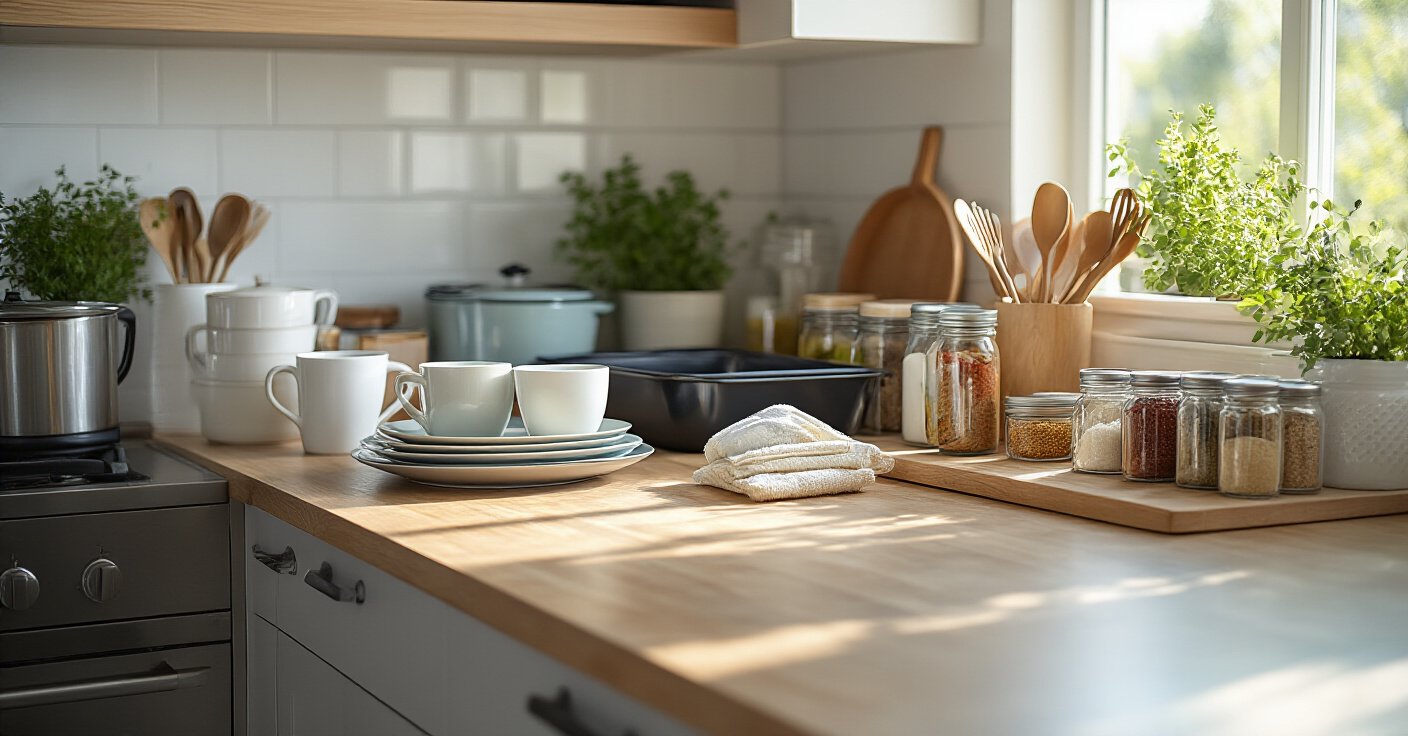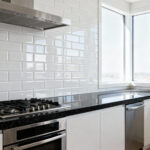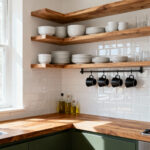Picture this: You’re standing in your kitchen. It’s 6 PM. The countertop is a graveyard of mail, half-used bags of oats, and that blender you swore you’d use every day. You open a cabinet to find an avalanche of mismatched plastic containers, and the pantry has three open bags of quinoa because you can never find the first one. This isn’t just a mess; it’s a symptom of a system that isn’t working for you or the planet. It’s stressful, inefficient, and incredibly wasteful.
But what if I told you that the most stylish, functional, and beautiful kitchens are also the most sustainable? It’s true. The principles of good design—efficiency, purpose, and thoughtful use of materials—are the exact same principles that guide a more eco-conscious life. We’re not talking about a total gut renovation or buying a mountain of plastic bins. We’re talking about a mindset shift. It’s about creating a space that nurtures you, saves you money, and helps you live in better alignment with your values. Let’s get into the real stuff, the changes that actually matter.
Section 1: Foundations – Assess, Declutter, and Plan
Before you buy a single container, you have to do the groundwork. This is the part everyone wants to skip, and it’s the only part that guarantees long-term success. Think of it as creating a blueprint for a healthier home. Without this foundation, you’re just organizing clutter, and that chaos will always creep back in.
1. Conduct a Thorough Kitchen Inventory: Know What You Own
You know what people always ask me? “Where do I even start?” My answer is always the same: you have to shop your own kitchen first. That means emptying everything—and I mean everything—out of your cabinets and pantry. Line it all up on your counter and get brutally honest about what you have. This isn’t just about tidying up; it’s data collection for a more sustainable life.

The real goal here is to confront waste head-on. Did you know the average American family throws away thousands of dollars worth of food every year? A huge chunk of that is because we buy duplicates of things we already own but can’t find. When you see your three bottles of paprika and a can of beans from 2018, it clicks. This step alone can slash your grocery bill and, more importantly, reduce your “foodprint.” Wasted food rotting in landfills is a massive producer of methane, a potent greenhouse gas. Your organized pantry is a legitimate tool for climate action.
Now, with everything out, you can get to the work that matters. The next step is sorting with intention.
2. Implement the ‘One Year Rule’ for Effective Decluttering
Can we talk about the biggest lie we all tell ourselves? It’s “I might need this someday.” That waffle maker you haven’t used since 2020? The novelty ice cream scoop? They aren’t just “things”; they are physical representations of resources—energy, water, materials—that are sitting dormant in your home. The ‘One Year Rule’ is your escape hatch. If you haven’t used it in the last 12 months, it’s time for it to find a new home where it will actually be used.

I once worked with a family who had an entire cabinet dedicated to “specialty” appliances they never touched. That’s prime real estate! By applying this rule, we freed up an entire lower cabinet. They donated the items, which is a beautiful act of circular economy—keeping usable goods out of the landfill. The clutter you’re holding onto could be exactly what someone else needs. Let it go. Be ruthless. Your sanity, and the planet, will thank you for it.
Once you’ve pared down to the essentials, you can start putting them back in a way that actually makes sense.
3. Map Out Functional Zones for Efficient Workflow
Think about how you move in your kitchen. Where do you make coffee? Where do you chop vegetables? Where do the kids grab their snacks? A truly sustainable home is an ergonomic one—it’s designed to conserve your energy. Mapping out functional zones means storing things exactly where you use them. Coffee mugs and coffee beans go by the coffee maker. Knives and cutting boards go near your main prep space. Spices and oils go near the stove. It’s so simple, but it’s a total game-changer.

This isn’t just about saving a few steps. It’s about reducing the daily friction that makes cooking feel like a chore. I designed a “lunch-packing zone” for a busy family, with containers, bread, and snack bins all in one spot. It cut their morning chaos by 15 minutes. That’s 15 more minutes of calm, of connection. When your space flows, your life flows. You’re more likely to cook at home, which is healthier, cheaper, and almost always has a lower environmental impact than eating out.
To make sure your new zones are perfectly equipped, precise planning is next on the list.
4. Measure Cabinet and Drawer Interiors Accurately for Fittings
I once had a client who was so excited to organize that she bought $200 worth of beautiful bamboo drawer dividers online. The problem? She just guessed the sizes. Not a single one fit. That’s a perfect example of how good intentions can still create waste—the packaging, the shipping emissions from the return, the frustration. The shortcut you wish you knew is simple: measure twice, buy once.

Before you purchase any inserts, dividers, or Pull-out shelves, grab a steel tape measure. Measure the interior width, depth, and height. And here’s the pro-tip everyone misses: measure at the front and back, because old cabinets are rarely perfectly square. Write down the smallest dimension. Pay attention to obstructions like hinges or plumbing. This tiny, ten-minute task is the difference between a seamless, beautiful fit and a wasteful, frustrating return.
Section 2: Maximizing Interior Cabinet & Drawer Space
Okay, your blueprint is done. You know what you’re keeping and where it should live. Now we get to the fun part: turning those dark, chaotic boxes into models of efficiency and beauty, using smart solutions that honor sustainable principles.
5. Install Pull-Out Pantry Shelves for Full Accessibility
Deep pantry cabinets are where good food goes to die. We’ve all been there. Installing pull-out shelves is one of the single greatest investments you can make in your kitchen. It’s not just about convenience; it’s a food waste prevention machine. When you can slide a shelf out and see everything you own, from front to back, you stop buying duplicates and start using what you have.
This is also a profound act of inclusive design. For anyone with mobility challenges or who struggles with bending and reaching, these shelves are a key to maintaining independence and joy in the kitchen. I recommended them to an older client, and she told me it was the first time in years she felt fully in control of her pantry. That’s what good design does: it empowers people.
With your deep spaces now fully accessible, let’s tackle those awkward, clanging stacks of bakeware.
6. Utilize Vertical Dividers for Trays and Cutting Boards
The sound of a clattering avalanche of baking sheets is the official soundtrack of a disorganized kitchen. Storing these items flat is a recipe for chaos and scratches. The solution is incredibly simple: store them vertically, like files in a filing cabinet. You can buy sturdy metal or bamboo dividers that install in seconds, or even use tension rods for a non-permanent solution.

This small shift has a huge impact. You’ll reclaim a surprising amount of space, but more importantly, you’ll protect your cookware. Good quality baking sheets and cutting boards are investments. When they’re not scraping against each other in a pile, they last so much longer. This is a core tenet of sustainability: buy good quality items and take care of them so you don’t have to replace them. It’s the opposite of our throwaway culture.
And for those other big, bulky items? Your deep drawers are waiting for their transformation.
7. Maximize Deep Drawers with Adjustable Organization Inserts
Deep drawers are a gift, but without structure, they quickly become a black hole for pots, pans, and food storage containers. The key is to create compartments with adjustable inserts. Forget flimsy, single-piece plastic organizers. I’m a huge advocate for modular systems made from Sustainable Materials like bamboo. Bamboo is a fast-growing grass that regenerates without replanting, making it a much more renewable resource than wood or plastic.
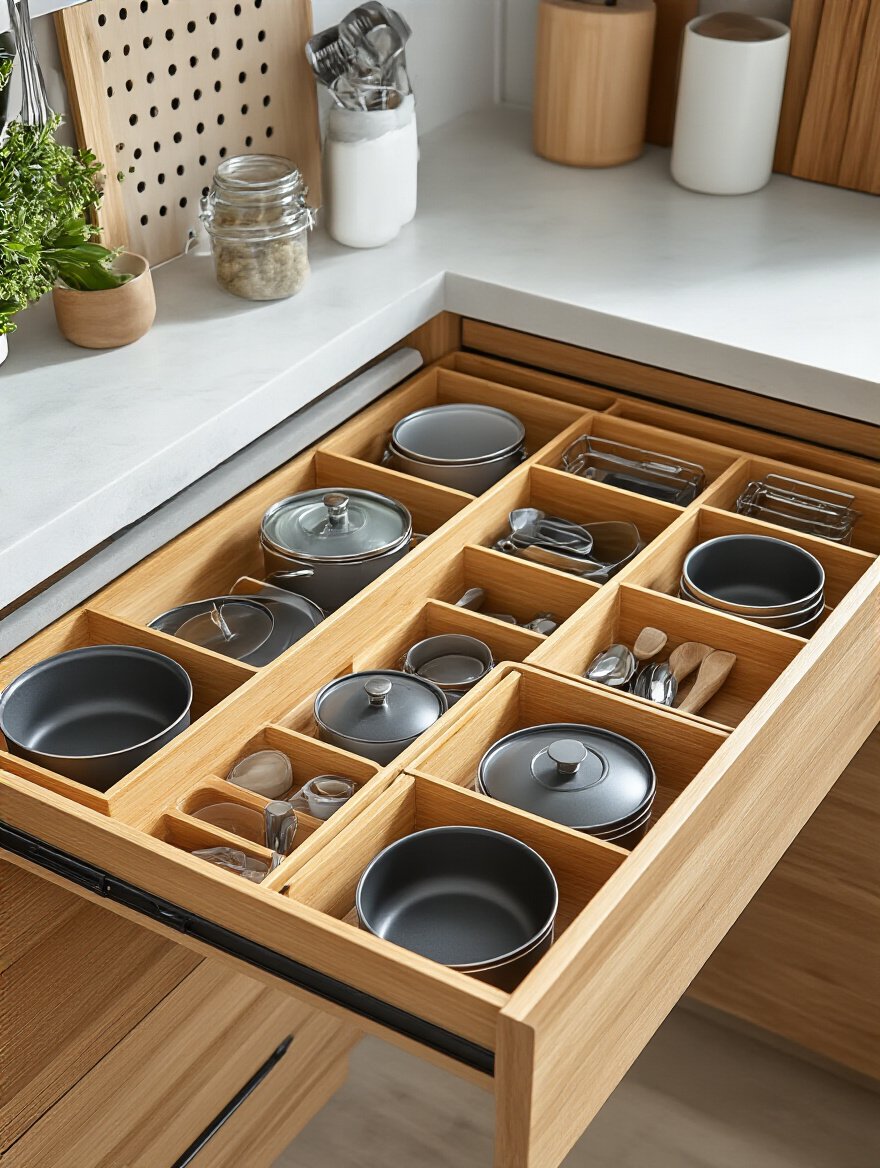
These dividers let you create custom-fit homes for your specific items. A dedicated slot for each pot, its lid right beside it. No more frantic searching. No more scratching the non-stick coating on your favorite pan. This brings a sense of calm and order that makes cooking feel less frantic and more mindful. It’s a small change that ripples through your entire Culinary Experience.
Now, let’s venture into the space everyone dreads: the abyss under the sink.
8. Deploy Under-Sink Organizers for Cleaning Supplies
The cabinet under the sink is a challenge. It’s dark, awkward, and home to plumbing. But with the right tools, it can become incredibly functional. I love using pull-out caddies and tiered shelving here. But the most important thing I recommend to every client is a waterproof mat. This is non-negotiable. A small, undetected leak from a cleaning bottle or a pipe can destroy a cabinet, leading to costly repairs and wasted materials.
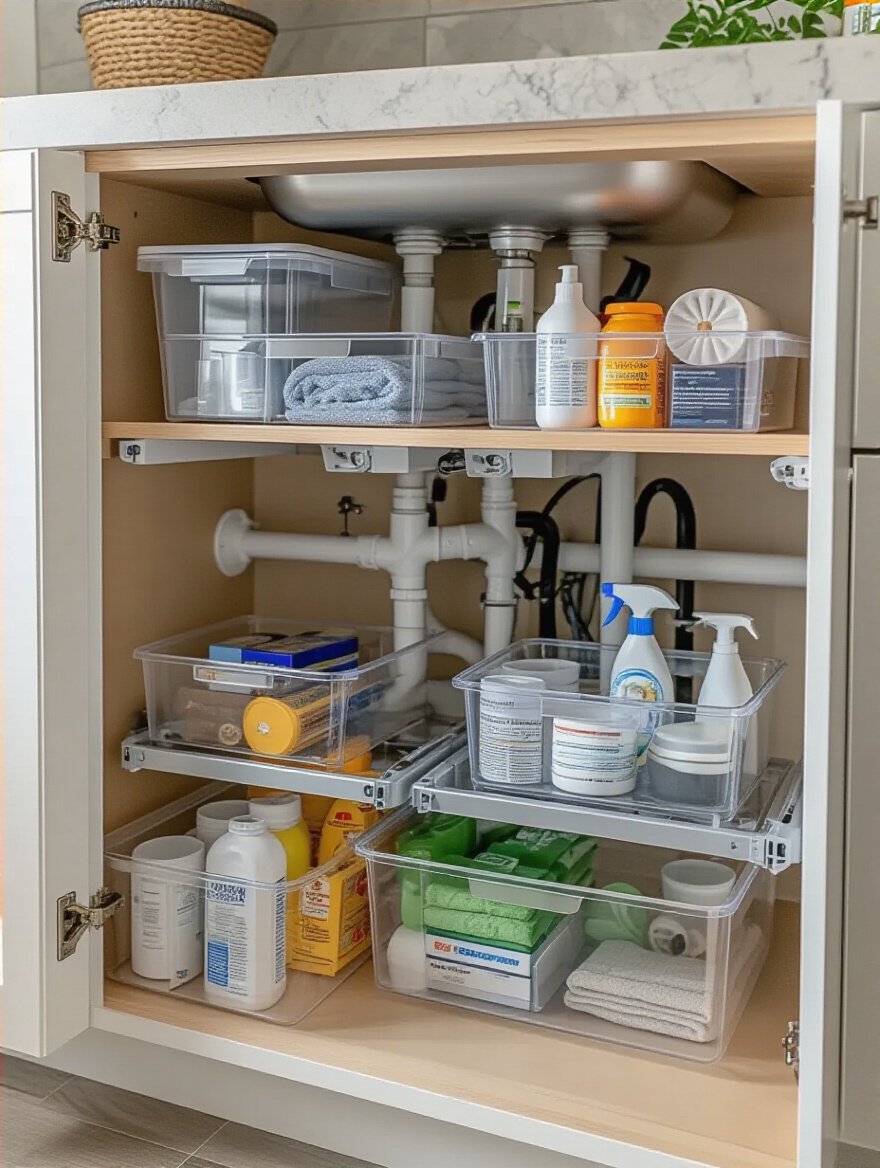
When choosing organizers for this space, look for durable, easy-to-clean materials. This is one of the few places where I recommend recycled plastic because it stands up to potential spills and moisture. By containing your supplies, you’re not just organizing; you’re protecting your home and preventing waste. Group your dish supplies in one caddy and your surface cleaners in another. It will make your daily clean-up routine faster and so much less of a hassle.
Section 3: Leveraging Vertical & Countertop Real Estate
So far, we’ve focused on what’s behind closed doors. But the surfaces and walls of your kitchen hold so much untapped potential. Using this space wisely is the key to achieving that clean, uncluttered look that is both calming and chic.
9. Mount Magnetic strips for Knives and Spices
Countertop knife blocks are bulky, take up prime real estate, and can be unhygienic. Drawers are even worse—they dull your blades and are a safety hazard. The most elegant solution, beloved by professional chefs and minimalist designers alike, is a wall-mounted magnetic strip. It gets your knives off the counter, keeps them sharp, and makes them instantly accessible. It’s form and function in perfect harmony.
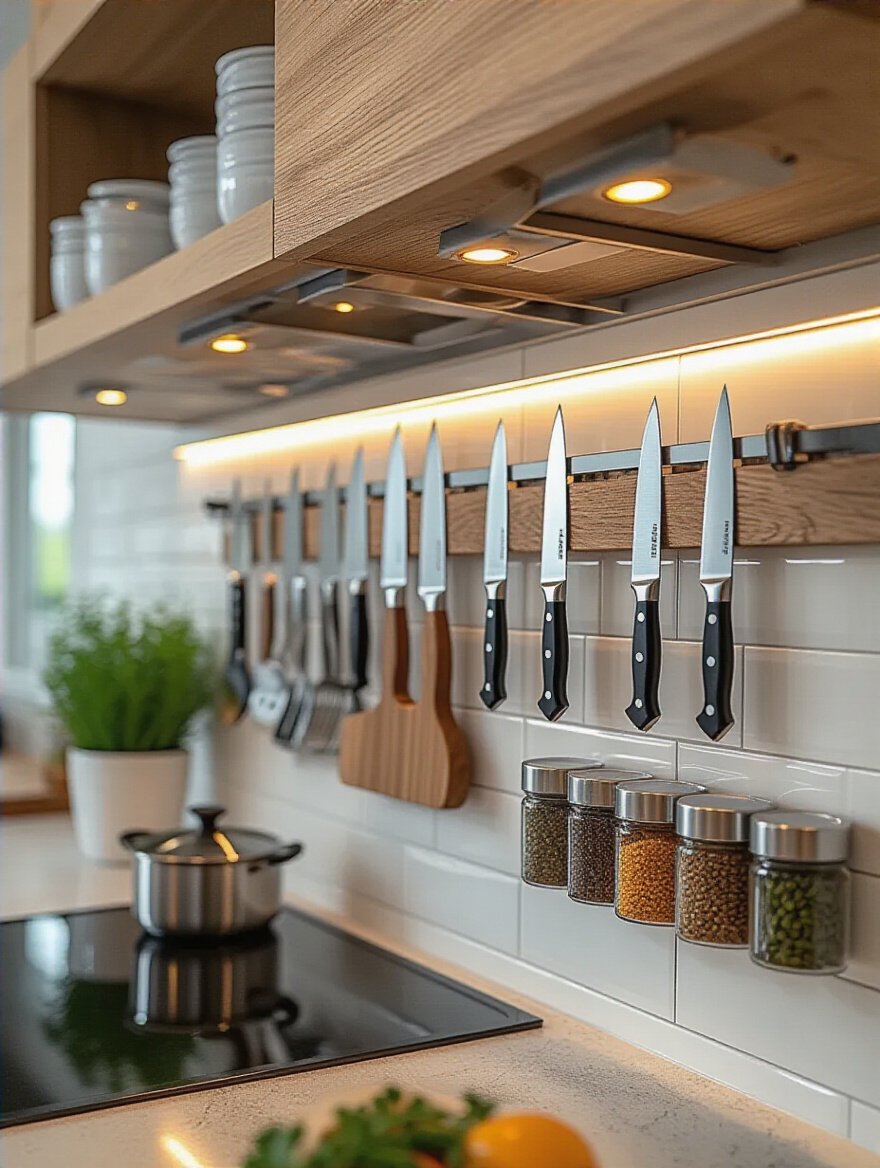
And don’t stop at knives! These strips are fantastic for metal spice tins. This frees up an entire shelf or drawer and turns your spices into a functional, beautiful display. I had a client in a tiny city apartment who thought she had no room to cook. We installed two magnetic strips—one for knives, one for spices—and it completely opened up her small prep area. It was a tiny change with a massive impact on her kitchen’s usability.
Speaking of getting things up on the wall, let’s talk about your heaviest hitters: your pots and pans.
10. Erect Wall-Mounted Pot Racks for Easy Access
Freeing up an entire lower cabinet is a kitchen revolution. That’s what a wall-mounted pot rack can do for you. By hanging your most-used pots and pans, you get them out of a jumbled pile and into the open where you can see and grab them easily. This not only makes your cooking flow smoother but also prevents the dings and scratches that come from aggressive stacking.
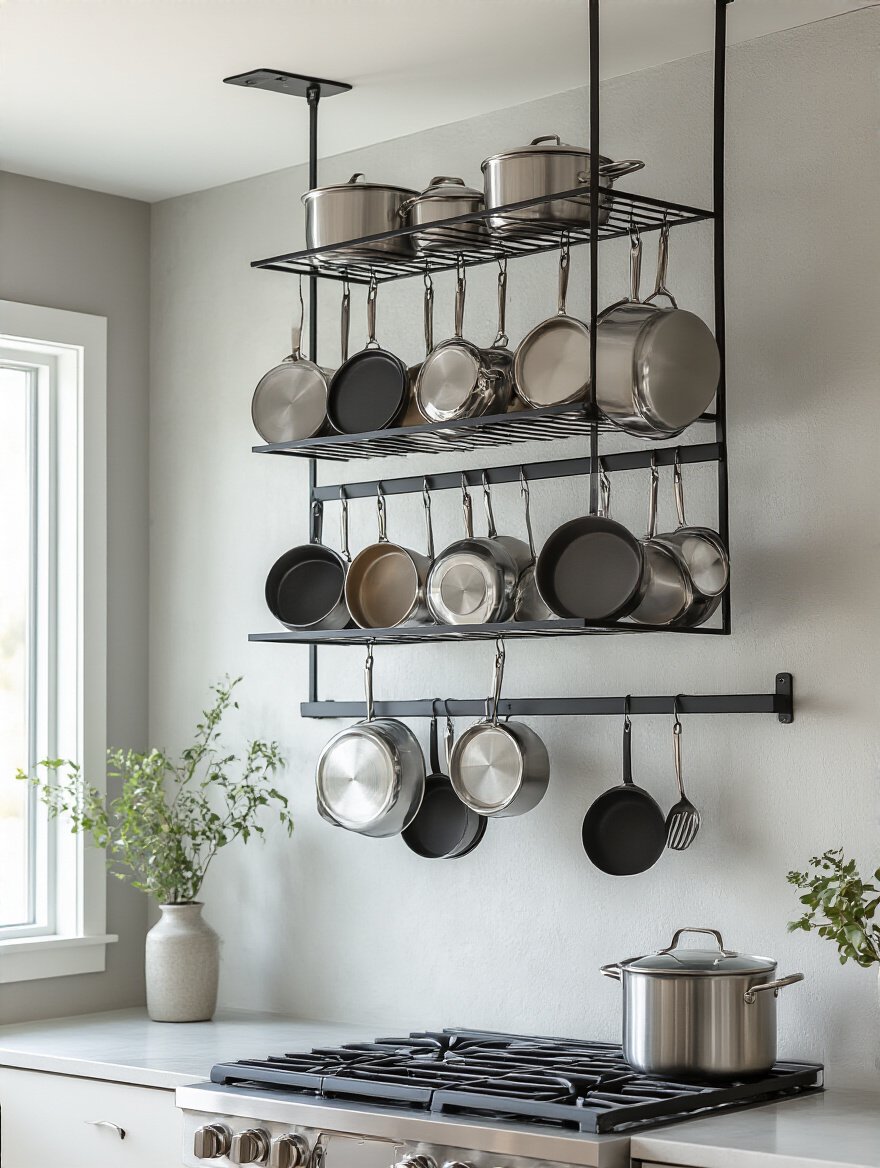
This is also an opportunity to add character and warmth to your kitchen. Look for racks made from durable, long-lasting materials like steel, iron, or reclaimed wood. It becomes a design feature—a beautiful, honest display of the tools you use to nourish your family. It says “this is a kitchen that is loved and used.” To me, that’s far more beautiful than hiding everything away.
With big items handled, let’s zoom in on those awkward corners that collect clutter.
11. Implement Tiered Corner Organizers on Countertops
Every kitchen has them: those dead corners where clutter seems to multiply. A simple tiered corner shelf is the perfect antidote. It uses vertical space to double or even triple your storage in that one small footprint. It’s the ideal spot for a little coffee station, with mugs on one level and sugar on another. Or use it for everyday cooking oils and seasonings.
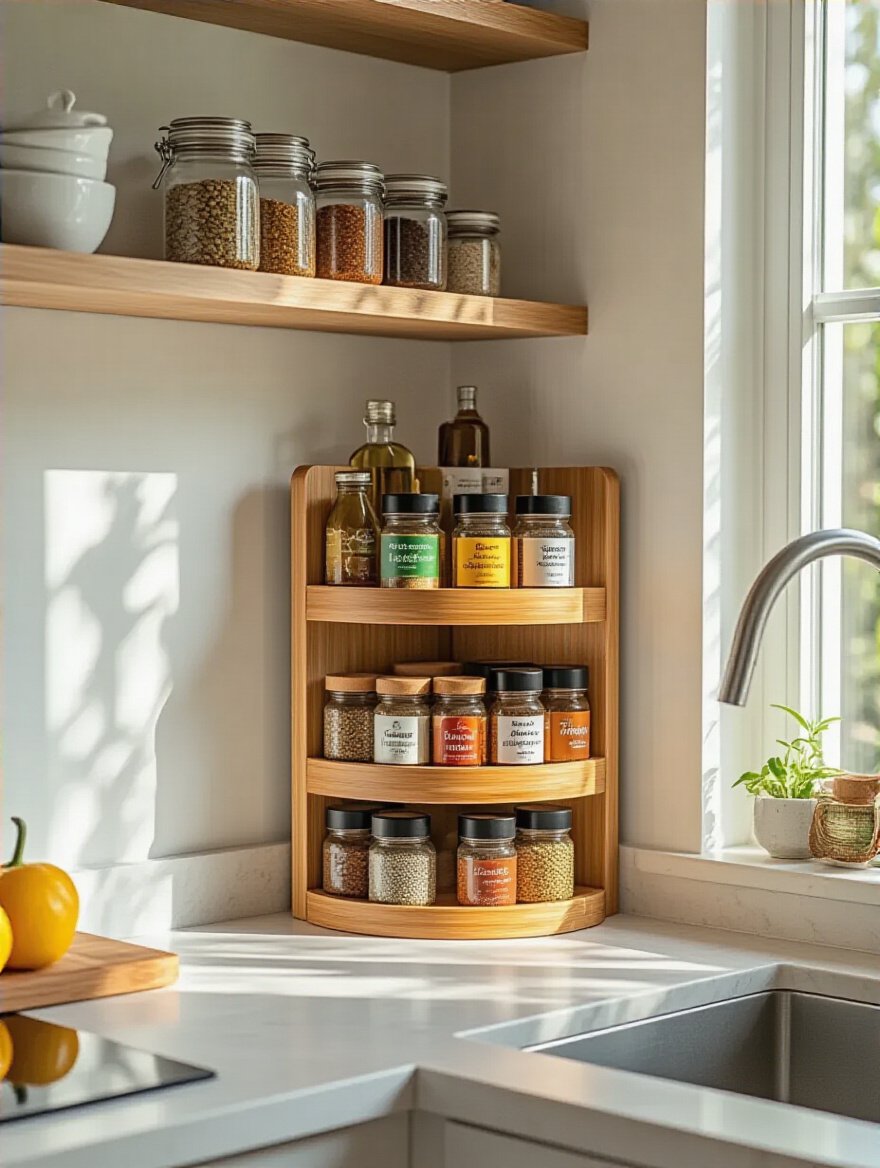
I always recommend these in materials that complement the kitchen, like warm bamboo or sleek stainless steel. The goal is to create a contained, intentional “moment” rather than just adding more stuff. By grouping like items, you transform a clutter trap into a functional, organized vignette. This brings visual order to your countertops, which instantly makes the entire kitchen feel calmer and more spacious.
For a more flexible approach to vertical storage, there’s nothing better than this next solution.
12. Install Pegboard Panels for Customizable Utensil Storage
If you want the ultimate in adaptable, personalized storage, look no further than the humble pegboard. It’s not just for garages anymore! A beautifully painted panel of pegboard on a kitchen wall or pantry door is a functional work of art. With an endless combination of hooks, shelves, and baskets, you can create a custom home for every whisk, spatula, and measuring cup you own.
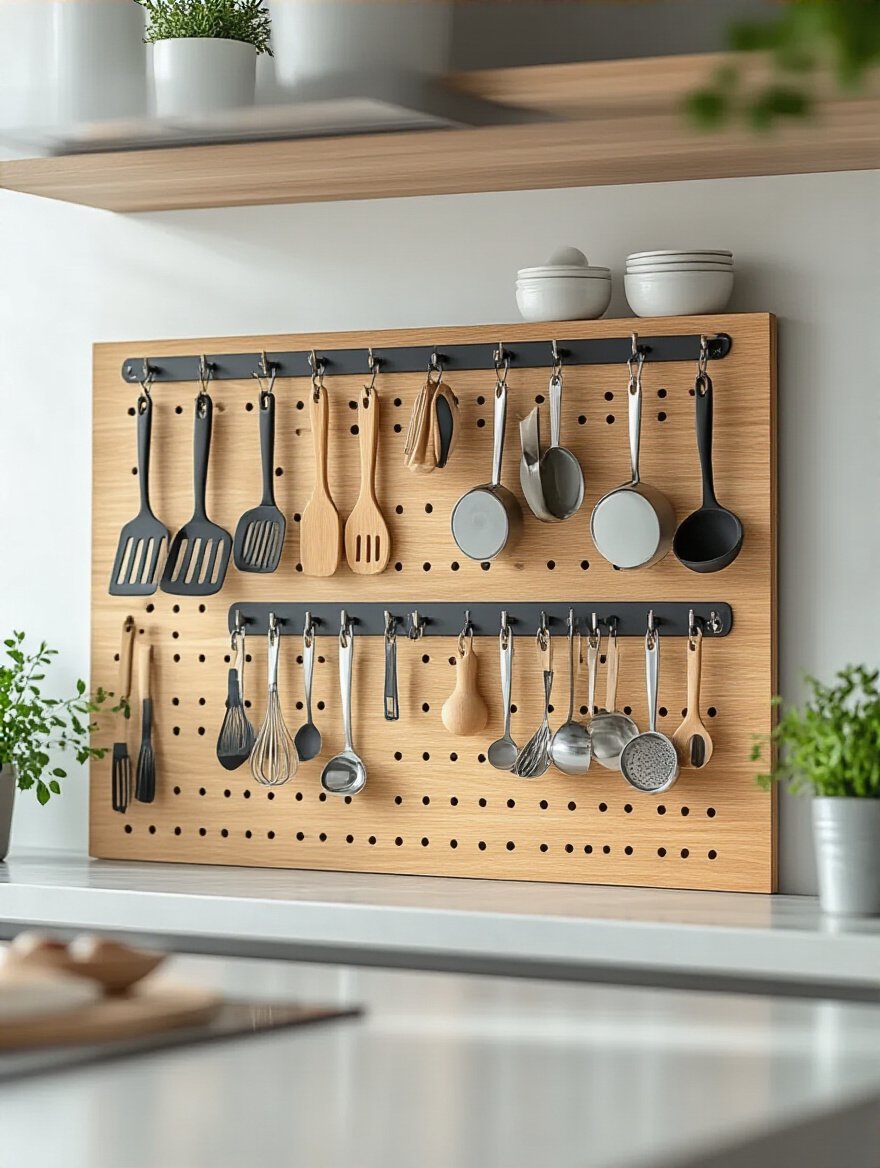
What I love most about pegboard from a sustainability perspective is its longevity and flexibility. As your tool collection changes, you don’t have to buy a whole new organization system. You just move the hooks. This “buy it once, adapt it forever” mindset is the heart of sustainable design. It reduces waste and allows your home to evolve with you. It’s the perfect way to get utensils out of your precious drawers and display them with pride.
Section 4: Creative Solutions for Specific Items & Spaces
Every kitchen has its own set of unique challenges. Now we’re going to zero in on those tricky items and awkward spaces with some clever, targeted solutions that will make you feel like a design genius.
13. Integrate Lazy Susans in Deep Cabinets for Access
I confess: I am obsessed with Lazy Susans. They are the unsung heroes of the organizational world, single-handedly solving the “deep, dark corner cabinet” problem. A simple turntable brings everything from the back to the front with a gentle spin. No more forgotten bottles of vinegar or half-used jars of molasses. You can see everything you have, which means you’ll use everything you have.

This is a powerful tool against food waste. Think about how many times you’ve bought a new bottle of soy sauce, only to find you already had two in the back of a cabinet. A Lazy Susan stops that cycle. I recommend them for spices, oils, condiments, and even under the sink for cleaning supplies. Opt for clear or bamboo versions with a small lip to keep items from flying off during a particularly enthusiastic spin.
With your corners conquered, let’s bring that same level of order to your pantry staples.
14. Use Stackable, Airtight Bins for Pantry Dry Goods
Decanting your dry goods into clear, airtight containers is probably the most transformative thing you can do for your pantry. Yes, it looks stunning, but the environmental benefits are even more compelling. First, airtight seals protect food from pests, moisture, and going stale, drastically extending shelf life and cutting down on food waste. Second, clear containers let you see your inventory at a glance, eliminating duplicate purchases.

And here’s the next-level eco-hack: this system allows you to buy in bulk. Shopping the bulk bins at your grocery store, using your own reusable bags and containers, is one of the most effective ways to reduce packaging waste. A kitchen set up with beautiful, uniform containers isn’t just an aesthetic choice; it’s an infrastructure for a lower-waste lifestyle. Choose glass or high-quality BPA-free containers that will last a lifetime.
Now, where do you put that bulky stand mixer that hogs half your counter space?
15. Create an Appliance Garage for Countertop Clutter
A clean, clear countertop is the ultimate kitchen luxury. But where do you put the toaster, the blender, the coffee maker? Enter the appliance garage. This is a dedicated cabinet, often sitting on the countertop, designed to hide your everyday appliances behind a door. When you need them, they’re right there. When you don’t, they’re gone. It’s a bit of design magic.
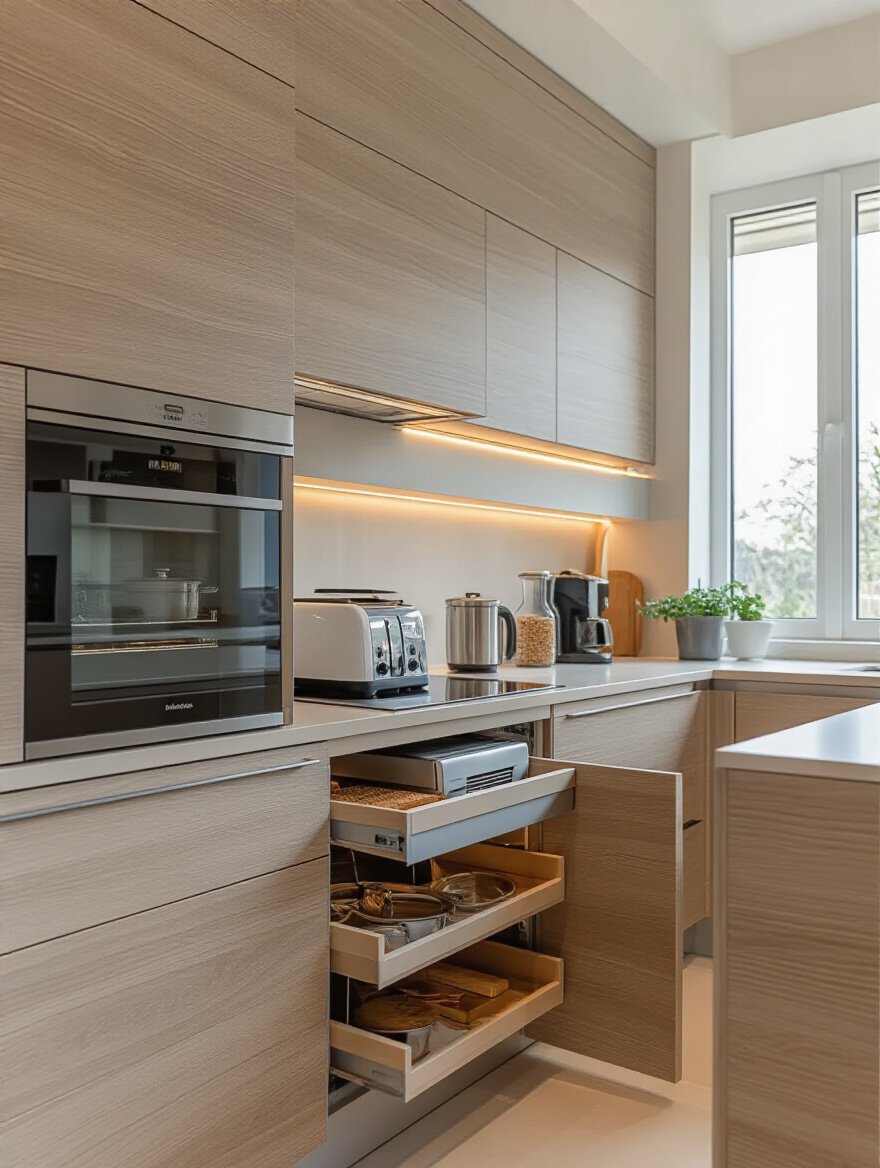
This has a profound impact on your mental state. Visual clutter creates mental clutter. Clearing your counters instantly makes your kitchen feel more serene and spacious. An appliance garage with a built-in outlet is the gold standard, allowing you to use the appliances right where they are. This might be a bigger project, but the daily payoff in calm and usability is immeasurable.
Finally, let’s bring that same order to the humble but hard-working cutlery drawer.
16. Dedicate Drawer Organizers for Silverware and Gadgets
The chaotic junk drawer is a cliché for a reason. But a home for everything and everything in its place is an achievable reality. The secret is drawer organizers that fit your stuff and your drawer perfectly. Forget those generic, one-size-fits-none plastic trays. Look for expandable bamboo organizers or modular systems that you can customize.
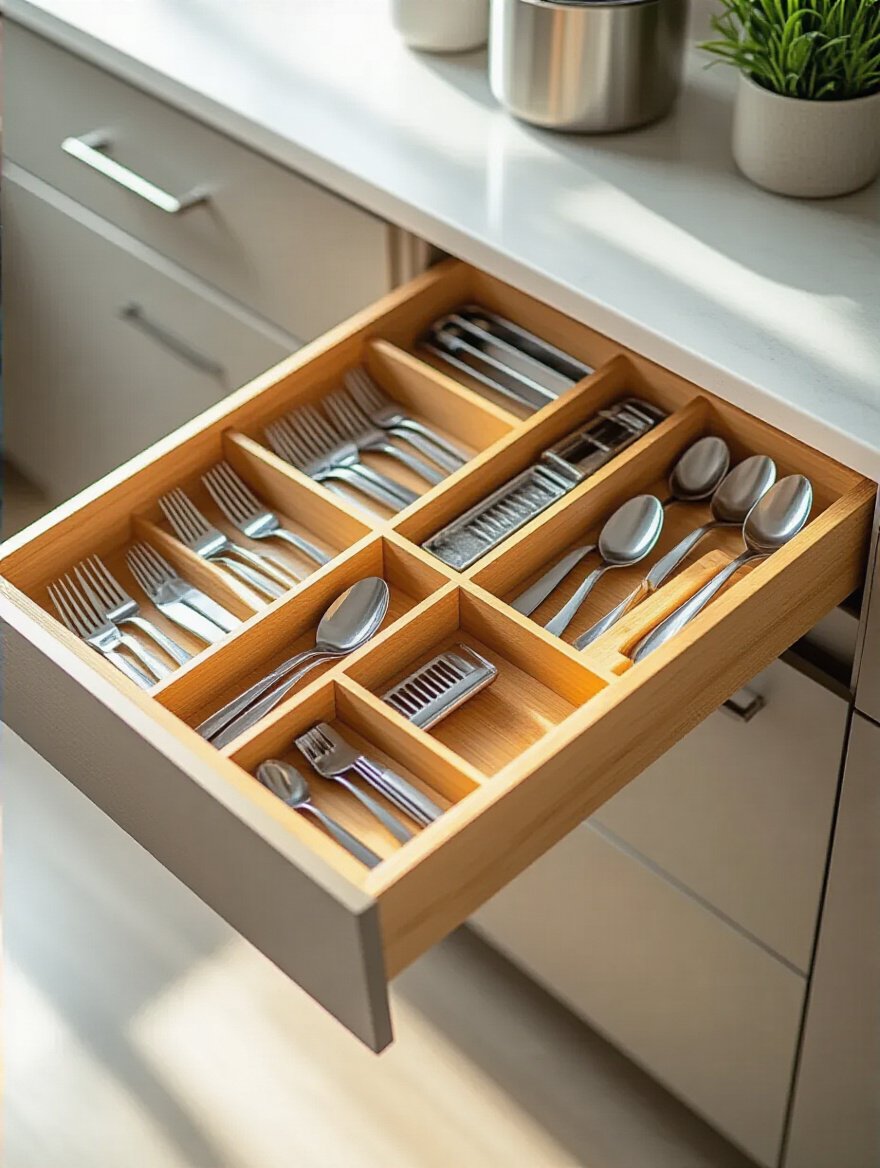
I had a client who was constantly frustrated because he could never find the vegetable peeler. We took 20 minutes, emptied the drawer, purged what he didn’t need, and installed an adjustable bamboo divider. He now has a dedicated spot for peelers and other small gadgets. He told me it was a “tiny, life-changing improvement.” That’s the power of intentional organization. It removes the small, daily points of friction that drain our energy.
Section 5: Long-Term Success & Maintenance Strategies
You did it. Your kitchen is a masterpiece of function and beauty. So how do you keep it that way? A truly sustainable system is one that lasts. These final habits are the key to protecting your investment of time and energy and ensuring your kitchen remains a sanctuary of order.
17. Label All Bins and Shelves for Quick Item Retrieval
Labeling is the step that locks in all your hard work. It’s the visual language that tells you—and everyone else in your household—where things belong. It takes the guesswork out of finding things and, just as importantly, putting them away. This isn’t just for you; it’s an act of kindness to your future self and your family.

You don’t need a fancy label maker (though they are fun!). Simple chalkboard labels, vinyl decals, or even just a strip of masking tape and a marker will do. Label the shelves, label the bins, label the spice jars. “When you give everything a name, you give it a home,” a wise organizer once told me. “It stops being clutter and starts being part of a system.” It’s what makes your new organization intuitive and effortless to maintain.
But even the best systems need a tune-up now and then.
18. Conduct Quarterly Maintenance Checks and Readjustments
Life changes. Your cooking habits evolve, your family grows, your needs shift. Your kitchen storage system needs to be able to shift with you. That’s why scheduling a quick quarterly “reset” is non-negotiable. It doesn’t have to be a massive overhaul. Just set aside an hour every three months to tidy up, re-evaluate, and make small adjustments.

During your check-in, scan for expired items in the pantry. Tidy up the spice rack. Re-apply the One Year Rule to any new items that have crept in. Is that bin for “Kid’s Snacks” still working, or do you need a different setup? This proactive maintenance prevents the slow creep of chaos and ensures your kitchen continues to be a space that supports you, rather than one you have to fight against.
Conclusion
A well-organized kitchen is so much more than a pretty picture on social media. It’s a living, breathing space that can genuinely improve your quality of life. By focusing on smart, sustainable solutions, you create a system that reduces waste, saves money, and frees up your mental energy for the things that truly matter—like enjoying a beautiful meal with people you love.
Remember, this is not about achieving perfection overnight. It’s about taking one small, intentional step at a time. Pick one drawer. Tackle one cabinet. Start with what’s bothering you the most. Every little change you make builds momentum, creating a ripple effect that transforms not just your kitchen, but your relationship with your home. You have the power to create a space that is beautiful, functional, and a true reflection of your values. Now go reclaim your space, and your sanity.
